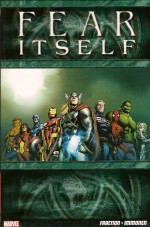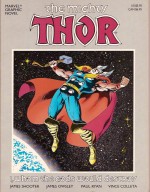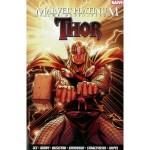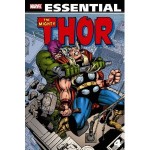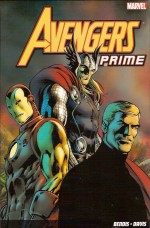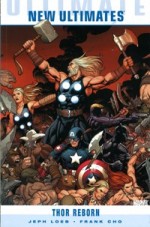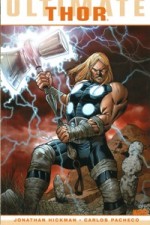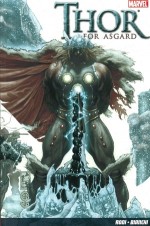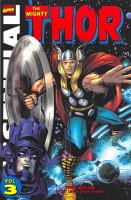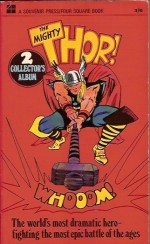
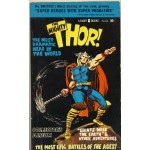
By Stan Lee, Jack Kirby & various (Lancer/Four Square)
“ISBNs†72-125 (Lancer) & 1918 (Four Square)
Here’s another brace of Swinging Sixties “Pop-Art†compendiums celebrating the meteoric rise of the Little House that Stan, Jack and Steve Built which will probably be of interest only to incurable nostalgics, consumed collectors and historical nit-pickers, but as I’m all of them and it’s my dime…
Far more than a writer or Editor; Stan Lee was also a master of entrepreneurial publicity generation and his tireless schmoozing and exhaustive attention-seeking was as crucial as the actual characters and stories in promoting his burgeoning line of superstars.
In the 1960s most adults, especially many of the professionals who worked in the field, considered comic-books a ghetto. Some disguised their identities whilst others were “just there until they caught a breakâ€. Stan and creative lynchpins Jack Kirby and Steve Ditko had another idea – change the perception.
Whilst Kirby and Ditko pursued their respective creative credos and craft, waiting for the quality of the work to be noticed, Stan pursued every opportunity to break down the ghetto walls: college lecture tours, animated shows (of frankly dubious quality at the start, but always improving), foreign franchising and of course getting their product onto mainstream bookshelves in real book shops.
There had been a revolution in popular fiction during the 1950s with a huge expansion of affordable paperback books and companies developed extensive genre niche-markets, such as war, western, romance, science-fiction and fantasy.
Always hungry for more product for their cheap ubiquitous lines, many old novels and short stories collections were republished, introducing new generations to fantastic pulp authors like Robert E. Howard, Otis Adelbert Kline, H.P. Lovecraft, August Derleth and many others.
In 1955, spurred on by the huge parallel success of cartoon and gag book collections, Bill Gaines began releasing paperback compendiums culling the best strips and features from his landmark humour magazine Mad and comics’ Silver Age was mirrored in popular publishing by an insatiable hunger for escapist fantasy fiction.
In 1964 Bantam Books began reprinting the earliest pulp adventures of Doc Savage, triggering a revival of pulp prose superheroes, and seemed the ideal partner when Marvel began a short-lived attempt to “novelise†their comicbook stable with The Avengers Battle the Earth-Wrecker and Captain America in the Great Gold Steal.
Although growing commercially by leaps and bounds, Marvel in the early 1960s was still hampered by a crippling distribution deal limiting the company to 16 titles (which would curtail their output until 1968), so each new comicbook had to fill the revenue-generating slot (however small) of an existing title. Even though the costumed characters were selling well, each new title would limit the company’s breadth of genres (horror, western, war, etc) and comics were still a very broad field at that time. It was putting a lot of eggs in one basket and superheroes had failed twice before for Marvel.
As Lee cautiously replaced a spectrum of genre titles and specialised in superheroes, a most fortunate event occurred with the advent of the Batman TV show in January 1966. Almost overnight the world went costumed-hero crazy and many publishers repackaged their old comics stories in cheap and cheerful, digest-sized monochrome paperbacks, and it’s easy to assume that Marvel’s resized book collections were just another company cash-cow, part of their perennial “flood the marketplace†sales strategy, but it’s just not true.
Lee’s deal with Lancer to publish selected adventures in handy paperback editions had begun a year earlier and the other funnybook publishers – including National/DC, Tower Comics and Archie – also desperate to add some credibility and even literary legitimacy to their efforts as well as increased profits these forays onto the world’s bookshelves – were caught playing catch-up in the fresh new marketplace.
Moreover, when Lancer began releasing Marvel’s Mightiest in potent and portable little collections it was simple to negotiate British iterations of those editions – although they were not as cheap and had far shorter page-counts – since thanks to Lee’s international expansion drive the characters, creators and stories were already very familiar to British readers, appearing both in Odhams‘ weekly comics Wham!, Pow!, Smash!, Fantastic and Terrific, but also (since 1959) in black and white monthly anthologies comicbooks published by Alan Class which had been bundling up reprinted material from a variety of American companies including Charlton, Tower, I.W., Gold Key, Archie, ACG and others.
As I’ve already mentioned US and UK editions vary significantly. Although both re-present – in truncated, resized monochrome – early Marvel tales, the British Four Square editions are a measly 128 pages, as opposed to the 176 page Lancer editions: necessitating missing stories and odd filler pages. Moreover the UK books are fronted by deliberately garish and poorly drawn “cartoony covers†instead of the American art by Ditko and Kirby, as if the publishers were embarrassed by the content…
Still, considering how many different prose publishing houses have chance their arm on such projects over the years, their editors must also have believed there was money to be made from comics too…
Also it’s impossible to deny that the book editions were fun, thrilling and just, plain cool…
In 1966 The Mighty Thor! Collectors Album was the fourth release from Lancer, with the British edition debuting a year later and although the US and UK editions are quite similar the latter frustrating omits an entire story – the concluding chapter of a two-part story!
Also glaringly omitted from both editions was the origin so in case you’re not au fait with the modern legend here’s a quick recap just for you…
Lonely, crippled American doctor Donald Blake took a vacation in Norway only to encounter the vanguard of an alien invasion. Trapped in a cave, Blake found a gnarled old walking stick, which when struck against the ground turned him into the Norse God of Thunder!
Within moments Thor was defending the weak and smiting the wicked and as the months swiftly passed rapacious extraterrestrials, Commie dictators, costumed crazies and cheap thugs gradually gave way to a terrifying parade of fantastic worlds and incredible, mythic menaces…
A word about artwork here: modern comics are almost universally full-coloured in Britain and America, but for over a century black and white was the only real choice for most mass market publishers – additional (colour) plates being just too expensive for shoe-string operations to indulge in. Even the colour of 1960s comics was cheap and primitive and solid black line, expertly applied by master artists, was the very life-force of sequential narrative.
These days computer enhanced art can hide a multitude of weaknesses – if not actual pictorial sins – but back then companies lived or died on the illustrating skills of their artists: so even in basic black and white (and the printing of paperbacks was as basic as the accountants and bean-counters could get it) the Kirbys and Ditkos of the industry exploded out of those little pages and electrified the readership.
I can’t see that happening with many modern artists deprived of their slick paper and multi-million hued colour palettes…
The mystic mayhem opens with ‘The Mighty Thor Battles… The Lava Man!’ (from the landmark Journey into Mystery #97, October 1963, by Lee, Kirby and Don Heck) wherein an invader from the core of the planet invades the surface world just as a rift between Thor and his father Odin was established when the Lord of Asgard refused to allow his son to love Blake’s mortal nurse Jane Foster.
This acrimonious triangle was a perennial sub-plot that fuelled many attempts to humanise Thor, because already he was a hero too powerful for most villains to cope with…
That titanic tussle was followed by ‘Giants Walk the Earth!’ (Lee, Kirby & Chic Stone, from Journey into Mystery #104, May 1964) the revolutionary saga where, for the first time, Kirby’s imagination was given full play as trickster god and wicked step-brother Loki tricked Odin into visiting Earth, only to release ancient elemental foes Surtur and Skagg, the Storm Giant from Asgardian bondage and bid them kill the All-Father….
This staggering cosmic clash saw noble gods bestriding the Earth, battling demonic evil in a new Heroic Age and this greater role for the Asgardian supporting cast set the scene for a far grander, more epic feel.
Also from JiM #97 comes the premiere instalment of a spectacular back-up series. ‘Tales of Asgard – Home of the mighty Norse Gods’ gave Kirby a place to indulge his fascination with legends. Initially adapting classic tales but eventually with all-new material particular to the Marvel pantheon, he built his own cosmos and mythology, which underpinned the company’s entire continuity. This first saga, scripted by Lee and inked by George Bell (AKA George Roussos) outlined the birth of the gods, the origin of the world and the creation of the World Tree Yggdrasil.
The British edition then concludes with ‘The Stronger I Am, the Sooner I Die!’ from JiM #114, March 1965, which began a two-part tale introducing a new villain of the sort Kirby excelled at, a vicious thug who suddenly lucked into overwhelming power, courtesy of the ever-scheming God of Evil.
Crafted by Lee, Kirby & Stone it saw Loki imbue hardened felon Crusher Creel with the magical ability to duplicate the strength and attributes of anything he touched and subsequently go on a brutal and frenzied rampage…
However, if you’d stuck with the American edition you’d also enjoy the senses-shattering finale as Thor demonstrated not just his power but also his wits in a blockbusting demonstration of ‘The Vengeance of the Thunder God’ (inked by Frank Giacoia as the pseudonymous Frankie Ray, which originally appeared in issue #115 from April 1965)…
As someone who bought these stories in most of the available formats over the years – including the constantly recycled reprints in British weeklies from the mid-sixties to the 1980s – I have to admit that the glossy classic paperback editions have a charm and attraction all their own even if they are heavily edited and abridged and rather disturbingly printed in both portrait and landscape format…
If you’ve not read these tales before then there are certainly better places to do so (such as the pertinent Essential or Marvel Masterwork volumes) but even with all the archaic and just plain dumb bits these books are still fabulous super-hero sagas with beautiful art that will never stale or wither, and for us backward looking Baby-boomers these nostalgic pocket tomes have an incomprehensible allure that logic just can’t tarnish or taint…
© 1966 and 1967 Marvel Comics Group. All rights reserved.

